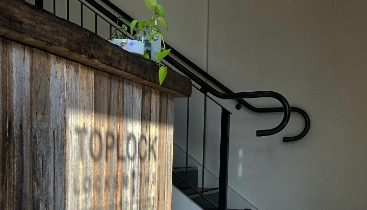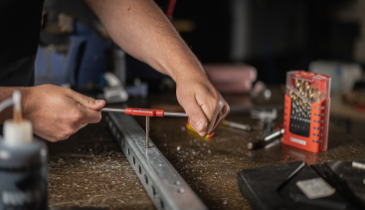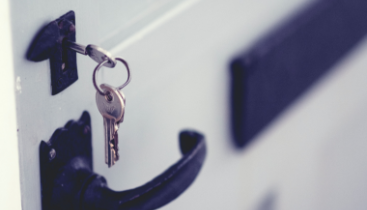Toplock’s top 12 Security Tips
Tip 1 Sneak Attack Sneakers by the door.
Yep, you read that right. I employed this old trick years ago at a residential property I had recently purchased. This was a brand new house that I had bought from the builder. It showed; many of the homes on the street were unoccupied. So, as soon as the deal was done and the papers signed, I drove right over and put a pair of sneakers right at the front door. Believe it or not the next day my real estate agent rang me at 7.00 am. “Are you in your new house?” he asked. “No, I’m not.”
“Well,” he said in a panic, “there’s a pair of sneakers at the front door. Someone’s in there! Should I ring the police?” PS – for best effect, use running shoes that are well worn in and a bit scruffy.
Tip 2 The Sound of Safety
Buy an inexpensive radio and turn it on when you are going out. Better yet, put it on a timer, so it comes on at various times during the day. Radios don’t use too much power and when they are on, they make it sound as if someone is at home. Why does this work? It has to do with the weakest link theory. Burglars rob a home that is the weakest link. Weak link homes and businesses are ones with inferior security and those that do not seem to be lived in. The sound of music playing really makes it seem as though someone is at home. It’s a small measure that can make a big difference.
Tip 3 Curb Your Thief
All homeowners are proud of their homes. We all talk about curb appeal. How proud we are to drive up to our home when they have big bushy trees and colourful shrubs up front and centre. The problem is that those big trees and shrubs are perfect hiding places for burglars. Tall trees are ladders that thieves can use to climb into a second- storey window. Keep tall trees and fat bushes far from your home.
Do you like tall fences? You may think they keep people out, but what they also do is hide people once they are inside. If it must be a tall fence, make it an iron one that people can see through. The rungs should be spaced closely so that a person can’t fit through. So, if it’s solid, keep it away from your house!
Tip 4 From Lawn to Garage
Most burglars don’t walk around with a jimmy bar in their pocket. Some carry a few handy tools with them, but most times they will use something they find lying around the yard to help them break into a home. Garden tools are used for smashing windows; ladders help thieves get to those windows on the second floor at the back of the house. Long- handledshovels with steel heads are particularly useful. Keep these and similar items locked up tight inside a shed. Don’t scrimp on the locks of your shed.
Better yet, keep tools in your garage. You think that’s inconvenient? Think about this: what’s more inconvenient? Having to walk to your garage to pull out your garden shears, or having to deal with losing your valuables and feeling insecure because you’re been burgled?
Tip 5 No Sensory Deprivation
Think about it. Are you more likely to do a nasty deed if someone can see you or if they can’t? I’ll answer that one for you. Nobody wants to be caught being naughty. That even applies to burglars.
Sensor lights are not expensive. These days, they can be mounted easily and run on batteries. Put them outside in all the nooks and crannies. Buy the kind that light up any time there is motion. You don’t even have to hardwire them. Low maintenance, easy to install.
No burglar wants to risk getting caught. The second that light shines, a thief, like a rat, will go scurrying. Put these up at the front and the back of your property.
An alternative is a timer light. These give the illusion that someone is inside the premises and can be set to come on and off at different times every night. A few of each kind, strategically placed, will provide an effective deterrent against night-time prowlers.
Tip 6 No Chains, Thank You
Hardware stores sell a lot of chains. We’re talking about the ones you put on your doorframes. They break easily. You open the door a crack, and immediately someone can stick their foot in; apply a bit of force and crack, the chain busts and a burglar, thief, your nasty ex, or whomever, is standing right next to you. But that’s not the main reason why we’re not a big fan of these. Many who buy them think it means their home is secure. It’s not. Things worse than feet can fit through a door opened even if the chain holds. These include a gun and a knife. Want to see who’s on the other side of your door? Install a peephole. If that’s not allowed? Just talk to the person. If you don’t recognize their voice, for sure, don’t open the door. No chain, no pain. That’s our answer and we’re sticking to it.
Tip 7 Stick It To ‘Em
Yes, keep that radio playing from time to time when you’re out and about. Get a CCTV. The fact remains: no matter how much you spend on security, thieves will always wonder, Is it real, or is it Memorex? (as the saying goes).
One thing is for sure. It’s kind of tough to buy something that looks like this: Maybe a friendly security company will give you such a sign – even if you’re not “signed up” – but, probably not. So, if you’ve got it, flaunt it. Place stickers announcing that you’ve got security protecting you and place them as close to your front door and windows as you can. Think they’re ugly? I’d rather a little ugly than a lot broken into.
Tip 8 Keep It Safe
It is absolutely amazing, but believe it or not thousands of people leave keys, jewellery, cash, their legal documents, discs with data lying in plain view all around the house. These items belong in a safe.
Safes come in all shapes and sizes. They can be wall-mounted or free standing and can be adapted for any application within your house or business.
There are three styles of safes: plate, steel fire safes and data. Safes are opened by either a key lock or a combination. The combination can be manual or digital. A plate safe is mainly used to store cash as these are hardest to break into. However, these are not fireproof, so if your house burns, your cash will go up in smoke.
A fire safe is steel on the outside but has an interior anti-fire coating. Contents placed within it will not burn for two hours. Cash, passports, important documents, jewellery, and keys are typically kept in this type of safe. A data safe is quite similar to a fire safe and is typically used inside a business to protect important data. What all these safes have in common is that they are heavy. They can even be bolted into cement. The fact that they are also locked makes it difficult for a burglar to get into what’s inside. So, if it’s valuable, and you want to keep it safe, buy a safe. It’s your best choice.
Tip 9 Pack It Up
We see it all the time, and so do you. It’s just that you’re not a burglar (we hope), so you don’t pay attention. But thieves do. You buy a high-ticket item like a TV. You unpack it, install it and you’re in hog heaven.
A few days later your house is robbed. Wonder why? You left a nice big sign in front of your house. “We’re rich. We bought a brand new TV.” In burglar- speak that’s, “We’re careless, take it away.”
Keep those boxes inside your garage. Wait until the morning your garbage or paper goods are being picked up. Better yet, break those boxes into small pieces before you dispose of them.
This goes double when you move into a new home. Don’t put all those boxes out on the street at once. That’s a sign that there are lots more packed boxes inside the home. They are all already packed. They’re probably labelled “master bedroom,” (that means jewellery). Or “kitchen” (that means silverware). Pack and unpack smart.
Tip 10 Stick It to It
This one is an oldie but a goodie. Almost every home has some sort of sliding door or window. If you’ve gotten this far, you probably know that this door or window should have a proper lock. Be that as it may, a lock can sometimes be picked, or it can get old and loosen easily. Add extra protection. Place a stick of wood in the track where the door or window slides back and forth. Don’t use a dowel. Many people try using a dowel rather than a piece of wood because dowels may be easier to find. The reason for using a stick of wood is its shape. It is not round; a dowel is. Therefore, a dowel can roll, or be easily pushed out of the track. A square piece of wood cut so that it fits snugly will make a door or window tough to jimmy open. Here’s what one looks like when it is properly placed in a window track.
Tip 11 Foolish Travels
When you’re away from home you should not leave your house empty.
It’s very worthwhile to have someone stay in your house if you intend to travel for any length of time. If you don’t know of anyone, go searching the internet for accredited house exchange organisations like Couchsurfing. If you’re not into having someone stay in your house, at least do the following when you’re out of town. Have someone pick up your mail. Put your lights and TV on timers. Have someone put garbage in front of your house on the day the garbage man comes (even if it’s their garbage). Make your house looked lived in, even when it’s not.
Tip 12 Peace of Mind
These tips aren’t going to prevent you from being burgled, and maybe you’ve heard some of them before. We hope that coming from professionals, you’ll pay attention to them! We’ve put this last because the intention of this book is to keep you and your possessions safe. Sometimes, however, there is just nothing you can do. You are out of town, that uninvited guest comes calling and you arrive home to find that your home has been burgled. If you have done the three things listed here, the rocky road ahead will be just a bit smoother. Yes, we’ll need to come out and rekey your home and your car. You’ll have a few other things to sort out. But, you’ll have a head start on getting back to life as usual.
ONE: Identify your belongings, both at home and at work. There are marker pens specifically designed for this. They are infrared. If your items are found by police, searched for at pawnshops, etc., one swipe with a proper light and they are proven to be yours.
TWO: About every six months, just go around your home and take pictures. Do so from various angles so you get photos of all the furniture, the items on the walls, the carpets, the cars. Open any cabinets that have expensive items in them. Use a video camera and verbally identify the items if you prefer. Keep pictures or discs in a proper safe or deposit box at the bank. In case of mishap you can prove what was taken. Your insurance company will love you. Also, take a picture whenever you buy something expensive.
THREE: Insurance. If you can’t afford to replace it but you must have it, insure it. Keep receipts.
Peace of mind is priceless.
Share This Story
More from Toplock Locksmiths
Qualities Of A Great 24-Hour Locksmith Melbourne Customers Look For
There’s no doubt that locksmiths play a special role in our society. As much as [...]
The Different Services Offered By A Locksmith – Brunswick
People call on locksmiths for different reasons. There are a variety of tasks performed by [...]
Where Would We Be Without A Locksmith, Northcote?
Locksmiths play an important role in society. They have a huge contribution in keeping the [...]
Looking for a Locksmith in Northcote?
Looking for the right locksmith in Northcote? TopLock Locksmiths offers a 24/7 service. Our phone [...]
Downsizing Your Keyrings
Keys are one of the most commonly misplaced items. This may because we have so [...]





